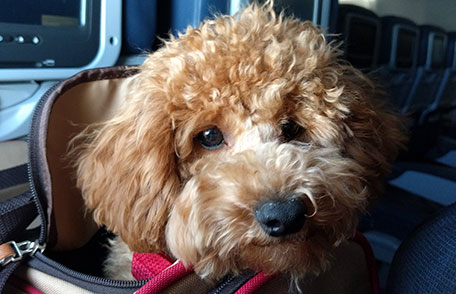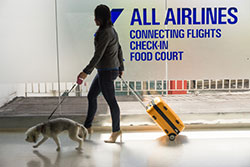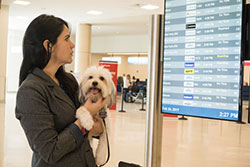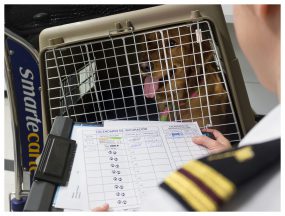Traveling with Pets
Starting August 1, 2024 at 12:01AM ET, new rules go into effect. Use the DogBot below to determine what rules apply to your dog based on the dates of travel and where your dog is traveling from.

Photo Credit: Audilis Sanchez, CDC
Taking your dog or cat on a flight abroad? Make sure you have your pet’s documents when traveling internationally and returning home to the United States. Leave yourself plenty of time before the trip to take care of your pet’s required medical care and paperwork. Remember to start the process early.
First Stop—Your Vet’s Office
If you are traveling internationally, tell your veterinarian about your plans as soon as possible. Together, you can make sure your pet is healthy enough to travel and meets the requirements for your destination country and for your return to the United States. Requirements may include
- Blood tests
- Vaccinations
- Microchips for identification
- Permits
- Health certificates
Airlines and countries often have different requirements, so make sure you know what the specific ones are.
Research How to Fly with Your Pet

Talk to your vet about your travel plans and your dog’s rabies vaccination. Photo credit: David Heaberlin, CDC
Give yourself plenty of time to do your homework before your trip. A great place to start is the Pet Travel website of the US Department of Agriculture’s Animal and Plant Health Inspection Service (APHIS).
Airlines
Different airlines have different rules about whether and how a pet can travel. Depending on the airline, your pet may be able to travel on your flight either in the cabin or in the cargo hold. Confirm this ahead of time with your airline.
On airlines that allow pets to travel, only small dogs and cats that can fit in special carriers under the seat are allowed in the cabin. Their owners must care for them during any layovers. Some airlines may not allow them in the cabin and will transport them as cargo in a heated and ventilated hold. Cats and dogs may travel and rest better this way, since it is quieter and darker, according to the International Air Transport Association.

Research how to fly with your pet. Photo credit: Misty Ellis, CDC
Another way for your pet to travel is on a separate flight as an air cargo shipment. If this is your preference, or a requirement based on your dog’s size or the destination country’s rules, then get your pet used to the shipping kennel ahead of time. Make sure the door latches securely to avoid any mishaps in transit. Ask your veterinarian for advice about when to give food and water. If a pet is traveling as an air cargo shipment, you must make arrangements for pickup at the final destination.
Some US carriers don’t allow pets to be shipped between May and September, the hottest months for animals to travel in the Northern Hemisphere. No matter what time of year, safety is always a concern when pets travel by airplane. If absolutely necessary for a dog or cat to travel in cargo, it must be in a sturdy container with enough room to stand and sit, to turn around normally while standing, and to lie down in a natural position. For more information, visit the US Department of Agriculture pet travel website.
When waiting for a connecting flight, you may have to care for a pet traveling with you in the cabin, while the airline staff or ground handlers care for a pet traveling in cargo. Check with your airline(s) beforehand to see what is required.
Consider Your Pet’s Comfort

Consider your pet’s comfort when traveling. Photo credit: Misty Ellis, CDC
Loading and unloading can be the most stressful part of travel for animals. Consider these tips:
- Get your pet used to its carrier before the flight.
- Purchase flights with fewer connections or layovers.
- Pick departure and arrival times to avoid extreme heat or cold. For example, planning a nighttime arrival to a hot destination may be better for your pet.
- Consult with your veterinarian. The International Air Transport Association discourages the use of sedatives or tranquilizers because they could harm animals while in flight.
- Walk your pet before leaving home and again before checking in.
- If your pet is allowed in the cabin, check in as late as possible to reduce stress.
- If your pet will be transported as cargo, check in early so it can go to the quiet and dimly lit hold of the plane.
Cruise Ships and Travel by Sea
Different cruise ships have different rules about whether a pet or service animal can travel with you and what documents they require. Confirm this ahead of time with your cruise ship. If you travel with your pets internationally on a cruise ship or other maritime vessel, you will be required to meet federal entry requirements to enter or re-enter the United States with your pets. Note that CDC has temporarily suspended the importation of dogs arriving from countries that CDC considers high risk for dog rabies, including dogs that have visited a high-risk country in the past 6 months.
Requirements for Dogs Leaving the United States
CDC does not have requirements for dogs leaving the United States. However, if you plan to return to the United States with your dog, the dog will be required to meet the same entry requirements as dogs arriving from foreign countries (see below). If you plan to take your dog to a country at high risk for dog rabies, be sure to review the importation requirements before leaving the United States, because your dog may not be allowed to return to the United States due to the current temporary suspension, which applies to dogs that live in the United States and have traveled to high-risk countries, even if only for a short visit.
Visit the US Department of Agriculture website for pet entry requirements in foreign countries.
Requirements for Dogs Arriving in the United States

Meet the requirements for dogs entering the United States. Photo credit: Derek Sakris, CDC
Whether returning or coming to the United States, all dogs must appear healthy. There is a temporary suspension for dogs imported from countries that CDC considers high risk for dog rabies.
Some states may require vaccinations and health certificates. Check with your destination state’s health department before you leave on your trip.
Some airlines, cities, or states restrict certain breeds, so be sure to check before you travel.
The US Department of Agriculture has additional restrictions for some dogs arriving in the United States, such as working dogs and dogs intended for resale or adoption.
Requirements for Cats Arriving in the United States
Cats aren’t required by CDC to have a rabies vaccination certificate to enter the United States. However, most states and many other countries require them for cats, and CDC recommends that all cats be vaccinated against rabies. Be sure to check your destination’s requirements and ask your veterinarian before traveling.
Other kinds of pets
If your pet is not a cat or dog, there may be different requirements. Some animals, such as primates (monkeys and apes) or African rodents, won’t be allowed back into the United States. Even if they originally came from the United States, they can’t be brought back here as pets.

With careful planning, your pet can stay healthy and safe while traveling. Photo credit: Audilis Sanchez, CDC
Illness or Death of a Pet During Travel
Despite all precautions, pets sometimes get sick or even die on an airplane. Public health officials are required to make sure an animal didn’t die of a disease that can spread to people. They may have to do an animal autopsy or conduct other tests, at your cost, to figure out the cause of death. The animal’s remains often cannot be returned to you after this testing.
Think of Different Options
Make sure your pet is healthy enough to travel by air. If you have any doubts, consider leaving your pet with a trusted friend, family member, or boarding kennel during your trip, or taking another mode of transportation.
With careful planning, your pet will arrive both at its destination and return home healthy and safe.
- International Dog Adoptions: Get the Facts
- Crate size, preparing pets for flight, feeding, shipping, and dealing with airlines:
- Laws for importing pets into the United States:
- Questions about traveling with your pet:
- Learn more about how to stay healthy while enjoying your pets